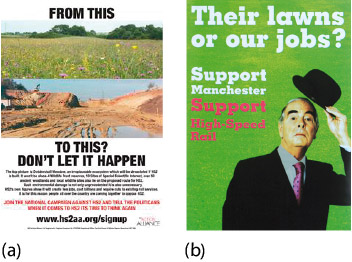4.3 Representing people in posters
Posters are a common method for communicating a vision to people. They are versatile and ubiquitous – they can be posted in bus stops and on billboards, or can be printed in newspapers and magazines. When well designed, posters create a strong visual impression so that they are easily noticed, clearly convey a vision and are remembered. As with statistical representations, they are designed to communicate a specific message to a specific group of people. For example, Figure 18 shows two posters that explore the impact of HS2 on people’s lives.
Activity 9 Evaluating representations
The two posters in Figure 18 are designed to convey a particular message to a particular demographic. For each poster, identify what the message is and who it is aimed at. Consider how effective the posters are at conveying these messages. Use the text box to record your thoughts.
Answer
The first poster was produced by the HS2 Action Alliance, to support the ‘against’ campaign. Visually, it highlights the cost of the HS2 scheme in terms of environmental impact, by contrasting between images of a wild meadow and a construction site. It is a poster that is intended to personalise HS2 and its consequences, with an aim to recruit people to join the campaign.
The second poster was produced by the Campaign for High Speed Rail, to support the ‘for’ campaign. It also personalises the HS2 scheme and presents the suggestion that jobs for the masses are more important than the property of the few. The poster is intended to encourage support for HS2 in Northern England, and responds to a perceived north/south class divide by presenting an argument for sharing wealth among the working class.
Both posters are potentially very effective at conveying their message, because they personalise the message to their target audience and aim to create an emotional response.

